
Business leaders have rapidly embraced generative AI, with adoption jumping from 55% to 75% within a year. This shift marks a crucial milestone in AI trends for 2025. Data and AI leaders report remarkable efficiency gains, as 58% of them see substantial improvements. Software engineers’ productivity has increased dramatically, with output growing up to 10 times through AI tools.
Companies now focus on practical applications rather than experiments. Their main areas include customer support, internal knowledge management, content creation and coding automation. A complete study of more than 500 companies shows mixed results despite $150 billion in private AI funding during 2024. Most organizations achieve modest returns from their original investments – cost savings remain under 10% while revenue growth stays below 5%. The report details how successful companies transform their AI investments into concrete business outcomes.
Why 2025 is a turning point for enterprise AI
The digital world of enterprise AI looks completely different now. The year 2025 marks a decisive shift from experimental projects to mission-critical implementation. IDC predicts global AI spending will surge to $632 billion by 2028, with an impressive 29% compound annual growth rate. This massive financial investment shows how businesses now see AI as an indispensable technology.
The signs of this turning point are clear. Enterprise AI applications now retain 63% of users after a year, up from 41% before. Furthermore, AI-focused companies reach $30 million in yearly revenue in just 20 months, while traditional SaaS businesses take 65 months. This rapid growth proves AI has evolved from a promising technology to a vital business foundation.
Major enterprises already show real results. JP Morgan’s AI-powered fraud detection cut false positives by 80%. Walmart’s AI inventory management reduced out-of-stock items by 30%. Companies are now rebuilding their operations around AI capabilities. About 21% of them have completely redesigned their workflows to make AI work better.
Regulations play a big role in this shift. US businesses might outperform their EU and Chinese counterparts in 2025 because of America’s flexible regulatory approach. On top of that, 42% of global business services tested generative AI in 2024, and 63% reported better productivity and cost savings.
Companies will boost their AI spending by 14% in 2025. Industry leaders expect 53% of their profits to come from AI investments. These investments go beyond simple productivity tools to systems that transform entire business models and speed up revenue growth.
Financial services, healthcare, and manufacturing lead the way in adoption. They use AI for precise diagnostics, fraud detection, and supply chain optimization. By late 2025, AI will be more than just part of enterprise operations – it will define them completely.
How 500+ companies were selected for this analysis
The data collection for our complete ai trends 2025 analysis started by understanding major market indices. We began with S&P 500 companies and analyzed their latest SEC Form 10-Ks from June 2024. This method helped us identify 359 S&P 500 companies that discussed AI in their 2023 financial disclosures, which represents 72% of the index.
We expanded our research of artificial intelligence 2025 by including Fortune 500 companies. The numbers were striking – 323 companies mentioned AI in their annual reports, showing a 152% jump from last year. Even more interesting, 281 Fortune 500 companies (56.2%) listed AI as a potential risk factor. This marks a massive 473.5% increase from just 49 companies in the previous period.
We selected organizations that showed real-life AI applications instead of theoretical discussions. Our focus was on companies that changed their operations using AI technology. These ranged from 10-year-old enterprises to new players in different sectors. This matches what industry experts see – enterprise ai trends 2025 are now taking root in conservative sectors that prove perfect for substantial AI adoption.
Our research applied strict standards to companies’ AI claims. We separated organizations that just talked about AI from those that showed measurable business effects. This helped us cut through market buzz and find genuine ai in 2025 use cases with clear results.
The final dataset covers companies of all sizes and AI maturity levels from different industries. This gives us a complete picture of how businesses implement generative ai trends 2025 in their operations. Such diversity helps us spot patterns in how each sector adapts to and benefits from ai technology trends 2025, moving beyond theory to document ground implementation.
Top industries leading AI adoption in 2025
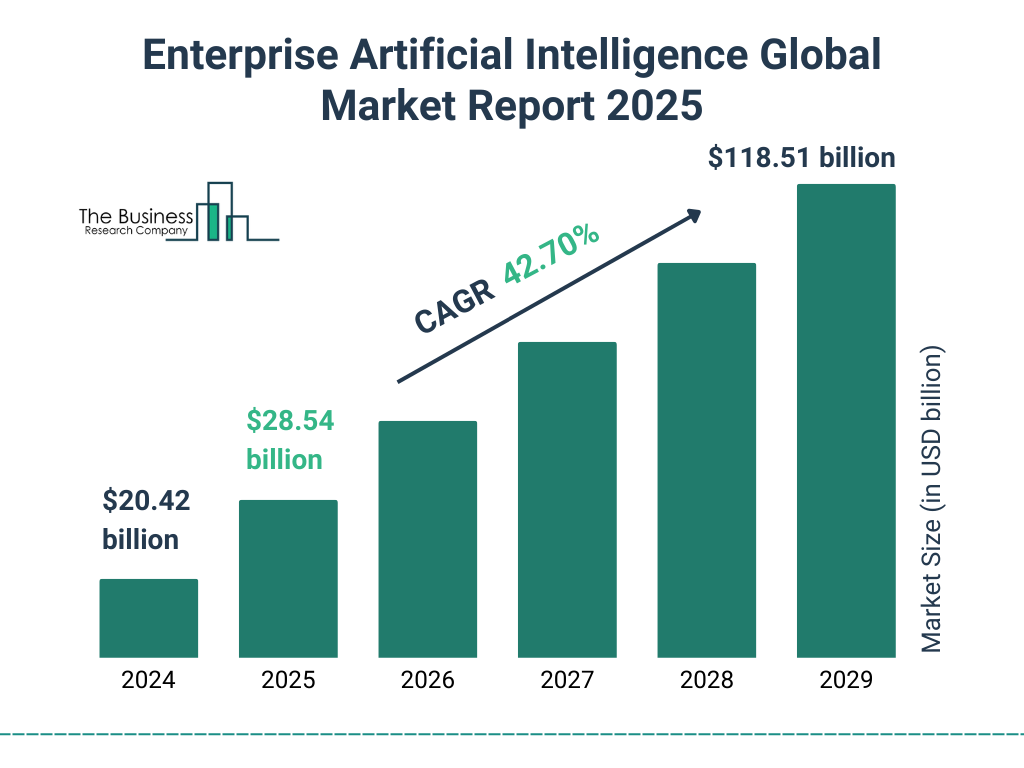
Image Source: The Business Research Company
The race for ai trends 2025 leadership has clear frontrunners as businesses rapidly adopt AI technologies. Recent studies show 78% of organizations now use AI in at least one business function. This represents a significant jump from 55% last year. Large companies lead this push toward artificial intelligence 2025. They adapt their operations faster than their smaller counterparts.
Financial services, healthcare, and manufacturing stand at the forefront of enterprise ai trends 2025. Financial institutions focus on boosting productivity with AI agents. These agents provide quick, accurate customer responses, speed up fraud alerts, and help professionals work better. Healthcare organizations face complex regulations. They prioritize AI solutions that streamline operations like appointment scheduling, clinical documentation, and claims processing.
Retail companies have made notable progress by using generative ai trends 2025 in their customer service centers. They automate call transcripts and provide smart responses to common customer questions. Manufacturing companies leverage ai technology trends 2025 differently. They create autonomous production lines and digital twins to simulate entire supply chains.
Government agencies show similar progress with 50% reporting high AI maturity levels. Media and entertainment businesses integrate ai in 2025 to streamline consumer services. They speed up back-office tasks and create tailored audience experiences.
A notable gap exists between how organizations view themselves and their actual AI implementation. While 49% of organizations consider themselves “advanced” in AI adoption, only 26% have successfully launched AI use cases. Companies remain confident about investing. They plan to increase AI spending by 14% year-over-year in 2025.
AI leaders report significant financial gains from their investments. Revolutionary companies expect 53% of their 2025 profits to come from AI implementation. This drives hiring plans, with 43% of companies looking to add AI-related roles throughout 2025. Machine learning engineers and AI researchers top the list of most wanted positions.
What defines real business results from AI
Companies must move beyond vague promises to concrete, quantifiable outcomes when measuring ai trends 2025‘s real business impact. McKinsey’s latest research shows that AI’s value comes from rewiring company operations. Workflow redesign creates the greatest EBIT impact from generative AI. Most companies still haven’t seen organization-wide, bottom-line impact from their AI initiatives.
A focus on specific, measurable results separates performative AI from transformative implementations. IBM research shows organizations use artificial intelligence 2025 to boost data analysis and decision-making. They also improve customer experiences, streamline processes, and boost cybersecurity practices. These applications create tangible value when properly arranged with business objectives.
Successful companies measure enterprise ai trends 2025 success through time-tested metrics. Tracking well-defined KPIs for AI solutions proves most meaningful for bottom-line value. Effective measurement frameworks track percentage reduction in operational costs through AI-driven automation. They also measure average lifetime value of AI-impacted customers and net promoter score improvements from AI-enhanced experiences.
McKinsey’s analysis reveals 63% of surveyed companies plan to increase their ai technology trends 2025 investment over the next three years. Companies with strategic implementation approaches see returns consistently. They understand that AI implementation needs clear business function knowledge and areas that AI can improve.
AI creates real business results by automating repetitive tasks and generating insights from big datasets. It predicts future outcomes and enables round-the-clock customer service with faster response times. Generative ai trends 2025 proves especially valuable for content creation. It deepens network security and improves supply chain management through predictive analytics.
Success with AI depends on an organization’s commitment to defining strategic objectives. Companies must track quantifiable metrics and establish governance guidelines. These efforts ensure AI initiatives directly stimulate business growth.
The shift from AI experimentation to execution
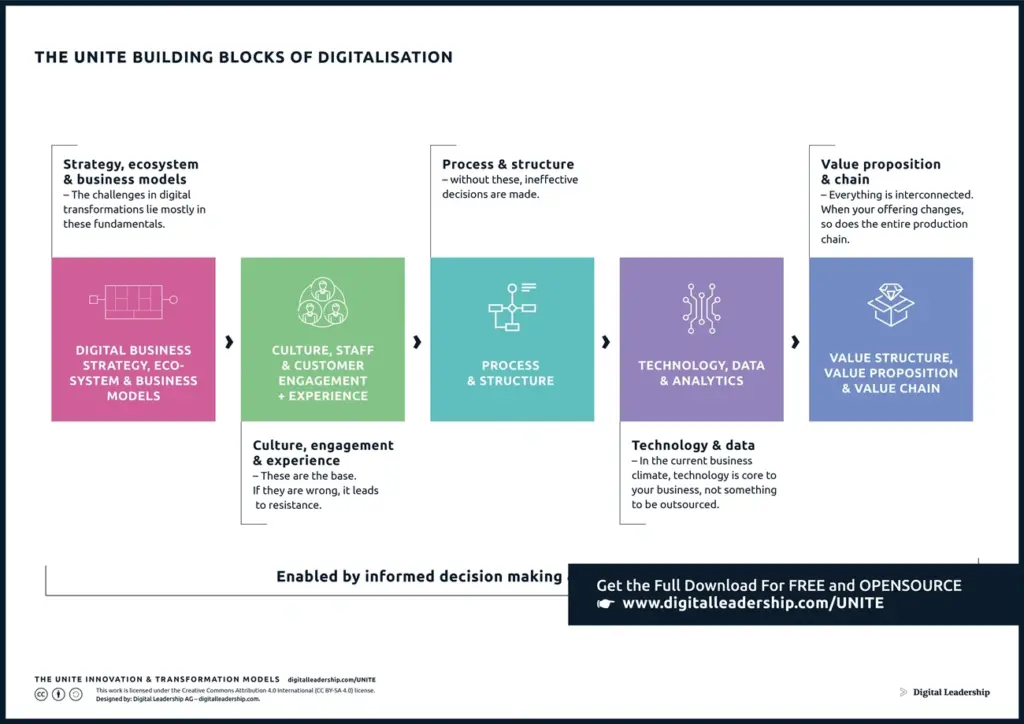
Image Source: Digital Leadership
Businesses are moving faster beyond AI experimentation as execution and delivery become the main focus. Gartner research identifies 2023 as the year of exploration and experimentation, whereas 2024-2025 demands delivery and execution. Organizations now must show real returns on their AI investments.
Data shows that 60% of CEOs will develop formal AI strategies by 2025, complete with well-laid-out roadmaps and ROI metrics. Companies are moving away from informal AI councils toward systematic adoption methods. Companies with structured AI initiatives were 20% more likely to exceed their growth targets in 2024.
Big challenges still exist. While ai trends 2025 point to increased implementation, organizations find it hard to keep momentum when scaling their efforts. McKinsey reports that companies can run experiments but struggle to create production-ready models. About 80% of AI projects never make it past proof of concept. Successful implementations take 3 to 36 months based on complexity.
Clear enterprise-wide strategies often provide the answer. Deloitte’s research shows that organizations with transformative results are three times more likely to have leadership-backed enterprise-wide AI strategies. In addition, successful companies focus on growth goals rather than just cutting costs.
Artificial intelligence 2025 will see MLOps rise—technologies and practices that ensure reliable model transition from lab to production through automated tasks, team collaboration, and monitoring systems. This approach keeps models current and builds trust in evidence-based decision making.
The best enterprise ai trends 2025 implementations begin with business goals, not technology capabilities. Organizations should avoid “AI for AI’s sake” and connect projects to measurable business effects. Companies that bridge this gap between experimentation and execution will gain a competitive edge in the evolving ai technology trends 2025 digital world.
How AI is reshaping business models
AI doesn’t just make operations better – it completely changes how businesses work across industries. McKinsey research reveals that while 25-30% of companies use AI in marketing, supply chain, and service operations, only 7% apply it to strategy and financial planning. This gap creates a great chance for companies that think ahead.
At its core, AI turns strategy from an occasional activity into an ongoing process that adapts in real-time based on data and insights. Companies that use AI to improve their business models are 1.5 times more likely to see major revenue growth than those that don’t. McKinsey breaks down AI growth into six key stages:
- Descriptive intelligence (automated dashboards)
- Diagnostic intelligence (understanding root causes)
- Predictive intelligence (anticipating future scenarios)
- Prescriptive intelligence (suggesting optimal actions)
- Autonomous intelligence (making decisions independently)
- Generative intelligence (creating new solutions)
McKinsey surveys show that AI creates an objective “momentum case” forecast that can reshape resource allocation discussions completely. The technology provides an unbiased, evidence-based foundation for strategic decisions.
The biggest changes come when companies create entirely new value propositions. ServiceNow changed from an IT service management company into an enterprise AI platform. This move expanded its market from $30 billion to more than $200 billion, leading to 85% revenue growth and 90% customer retention.
UnitedHealth Group’s AI platform has transformed healthcare delivery operations similarly. The company cut delivery costs by 30% and improved patient outcomes by 45%. These examples show how ai trends 2025 will move beyond improving existing models to creating new ones entirely.
The future of artificial intelligence 2025 points to business models with AI at their core, creating what Deloitte calls “AI-fueled™ organizations”. Companies are rewriting the rules of business value creation in months rather than years as they reshape how value is created and captured.
The role of AI in digital transformation strategies
AI fundamentally reshapes digital transformation by turning technology-centered efforts into strategic business initiatives. McKinsey’s research with over 200 large companies shows that digital excellence leads to better financial performance. The success depends on how organizations blend AI with their broader transformation strategies.
The enterprise landscape of 2025 needs digital transformation that treats AI as a key enabler within complete business strategies. Companies that create the biggest effect start by solving specific business problems instead of focusing on technology capabilities. They concentrate their transformation efforts on key business areas like production processes or customer experiences.
The best road maps yield EBIT improvements of 20% or more, which shows how artificial intelligence 2025 integration changes traditional approaches. A successful transformation needs six key enterprise capabilities. These elements connect with each other – a good operating model needs the right talent and great technology needs user adoption to work.
Enterprise ai trends 2025 point to distributed digital creation becoming the common model. The CIO helps the organization create securely with access to tools and data they need. This change gives every C-suite executive new responsibilities, and digital transformations ended up becoming people transformations.
Talent strategy plays another significant role. High-performing organizations keep 70-80% of digital talent in-house and aim for a 4:1 ratio of engineers to managers. Data governance grows more vital as ai technology trends 2025 advance. It provides structures to manage risks from advanced technologies.
Successful organizations know that digital transformation combines hundreds of technology-driven solutions. These create exceptional customer experiences while reducing unit costs. Generative ai trends 2025 will speed up this meeting point and enable better integration across customer experiences. Organizations that effectively implement ai in 2025 in their digital transformation frameworks will substantially outperform competitors and turn technology capabilities into lasting competitive advantages.
AI maturity levels across different sectors
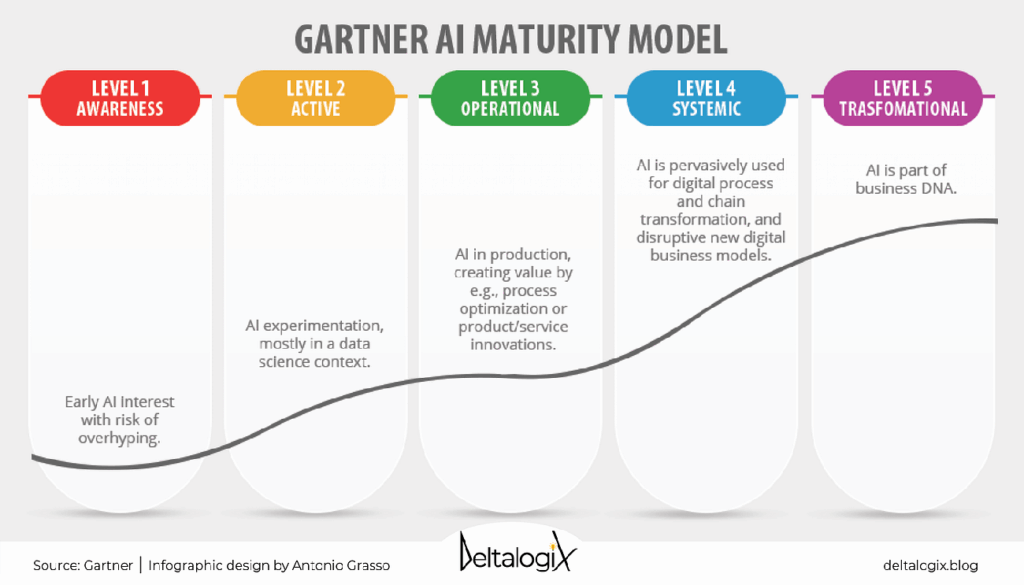
Image Source: Medium
Research shows a significant gap in ai maturity levels between industries. Only 7% of enterprises have reached peak AI readiness. The MIT Center for Information Systems Research has mapped out four stages of enterprise AI maturity that directly link to financial success. Companies in the first two stages usually perform below their industry average. Those reaching stages three and four show better financial results than their competitors.
The detailed maturity levels show this breakdown:
- Stage 1 (28% of enterprises): Teams focus on experimentation and preparation. They educate their workforce, create policies, and adopt evidence-based approaches
- Stage 2 (34%): Organizations build pilots and set metrics while they start automating processes
- Stage 3 (31%): Companies industrialize AI throughout their operations with adaptable architecture
- Stage 4 (7%): Businesses become “AI future-ready” and embed AI in every decision
The adoption of artificial intelligence 2025 varies significantly by company size. More than 50% of companies with 5,000+ employees use AI. This number jumps to over 60% for organizations with 10,000+ employees. Manufacturing, information services, and healthcare lead sector-specific adoption at 12% implementation. Construction and retail lag behind at roughly 4%.
Boston Consulting Group’s research shows industries that faced early digital innovation have the highest ai in 2025 maturity. Fintech leads at 49%, followed by software at 46%, and banking at 35%. The telecommunications sector stands out as the most AI-ready industry. It scores 34/100 on the HG AI Maturity Index – the highest among all sectors. This score still suggests room for improvement.
The current digital world reveals a notable gap between perception and reality. Many organizations consider themselves “advanced” in AI adoption. However, only 26% have built capabilities beyond proofs of concept that create real value. These findings highlight uneven enterprise ai trends 2025 implementation. AI technology trends 2025 adoption clusters appear in unexpected places beyond traditional tech hubs.
How companies are measuring AI ROI
Nearly half (49%) of organizations find it hard to measure the value of their AI investments and show returns on AI projects. Business leaders rate this challenge above talent gaps, technical issues, and data problems.
Leading companies have created detailed frameworks that break down AI returns into three key areas. Measurable ROI shows direct, countable gains like cost savings and higher revenue. Strategic ROI looks at how AI helps achieve long-term company goals over 3-5 years. Capability ROI shows how AI projects boost the company’s AI maturity through better skills and culture.
Businesses typically split benefits into two types. Hard returns can be counted in money, while soft returns help grow customer relationships and business indirectly. Hard metrics include better production lines, lower labor costs, and automated quality checks. Soft benefits include better brand awareness and happier employees.
Companies often make common mistakes when measuring AI ROI. Simple calculations miss data quality problems or model accuracy limits. Some check ROI too soon after launch and miss how performance might drop later. Of course, looking at AI results just once instead of tracking them regularly is a major mistake.
The best companies focus on business metrics rather than technical ones. Data scientists might care about technical measures like precision and recall, but these don’t show real business value. Smart organizations track metrics tied directly to business goals—more revenue, lower costs, and new customers.
Companies that excel at measuring AI ROI follow clear steps. They set clear goals, measure starting points, estimate costs fully, track key metrics regularly, use proper ROI formulas, and share results clearly with stakeholders. This well-laid-out process helps companies truly see how AI drives business growth as ai trends 2025 accelerate.
Top KPIs used to track AI success
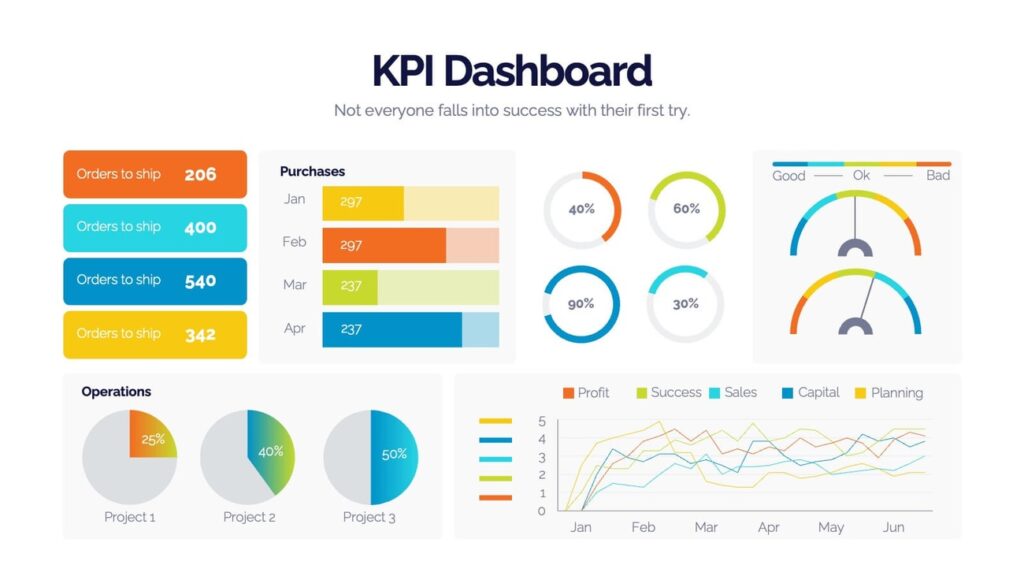
Image Source: Slidenest
ai trends 2025 show organizations moving away from technical metrics to business-oriented KPIs that show clear value. This radical alteration shows how companies now understand that technical excellence alone doesn’t guarantee real business results.
Companies now prioritize business value metrics over technical ones. They focus on revenue, profit, savings, and customer acquisition. These simple indicators connect to business goals and show the real worth of AI predictions. Data scientists often leave out these significant metrics from their reports.
Well-laid-out measurement frameworks sort AI KPIs into three categories. Model quality metrics review performance through quality indexes, error rates, latency, accuracy thresholds, and safety scores. System quality metrics look at operational aspects through data relevance, asset reusability, throughput capacity, system latency, and integration capabilities. Business impact metrics monitor adoption rates, usage frequency, session metrics, and user satisfaction.
Industry leaders have specific operational KPIs for different functions. Customer service teams track reduced handling time, better satisfaction, and agent productivity. Marketing departments measure time saved from efficient processes and higher ad spend returns. Healthcare facilities focus on increased patient time, improved outcomes, and shorter wait times.
Standard ML metrics like precision, recall, and lift show relative performance against baselines such as random guessing. However, effective KPIs demonstrate absolute business value. Generative AI needs metrics that review unbounded outputs through computation-based approaches and subjective criteria like coherence, fluency, and instruction following.
Smart organizations use AI-powered KPIs that work better than old indicators. Companies that make use of these improved frameworks are five times more likely to match incentive structures with objectives. This reshapes the scene not just in measuring success but in defining it.
AI in marketing: measurable outcomes
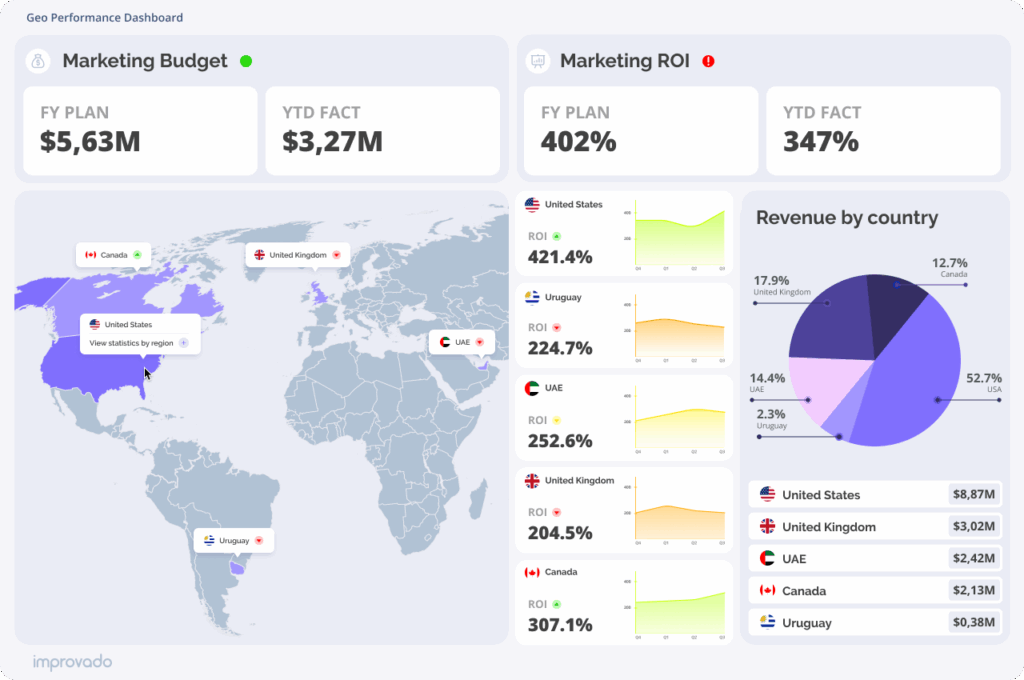
Image Source: Improvado
Marketing departments show remarkable and measurable returns from ai trends 2025. They outperform many other business areas. A complete McKinsey analysis shows marketing creates the highest value from AI compared to other fields. This success comes from AI’s natural fit with core marketing tasks: understanding customers, matching products to buyers, and boosting sales.
Numbers prove AI’s effect on marketing. Companies using AI-driven content strategies see their marketing ROI climb 20% higher than traditional methods. AI-powered customized content delivers 40% higher average order values.
Performance indicators tell a clear story. AI-optimized content gets 83% more reader involvement than traditional content. Brands that use AI to map customer interactions see 59% higher email opens and 27% more clicks across digital channels. Marketing campaigns with AI optimization achieve 41% better conversion rates than standard approaches.
Companies save money too. They cut marketing costs by 32% after adding AI content tools. Enterprise ai trends 2025 solutions make immediate optimization possible. AI changes A/B testing from static to dynamic optimization. It analyzes multiple ad versions at once and suggests quick changes.
Smart marketers now track success through:
- Time saved with streamlined processes
- Cost savings from spotting weak campaigns
- Audience involvement metrics
- Quality checks of AI-created content
Major online retailers use ai technology trends 2025 to watch ad performance. They move money from weak campaigns to ones that work better. This changes how marketing budgets work, making every dollar count. As generative ai trends 2025 grows, marketing teams continue to show solid, measurable returns on AI investments.
AI in sales: lead scoring and conversion rates
Sales departments are undergoing a transformation as ai trends 2025 move beyond simple automation toward sophisticated assessment of sales performance quality. The effect of AI on lead scoring and conversion rates emerges as one of the most measurable success stories in enterprise implementation.
AI has turned traditional lead scoring from a manual, intuition-driven process into a precise science. AI lead scoring systems analyze millions of data points to predict which prospects will likely convert. This capability fundamentally changes how sales teams prioritize their efforts. Organizations that use AI-enriched KPIs see three times more financial benefit than those using traditional metrics.
The numbers tell a compelling story. Companies using AI lead scoring see conversion rate increases of 9-20%. They also reduce churn rates by 13-31% because they identify at-risk customers earlier. AI-powered chatbots boost lead conversion rates by 28% when they qualify leads and direct them to appropriate channels.
Enterprise ai trends 2025 demonstrate how AI reviews the quality of sales interactions. Advanced tools analyze conversations immediately and assess whether representatives ask open-ended questions, respond with empathy, and build customer rapport. These systems detect emotional cues and monitor participation in training programs. This creates an all-encompassing performance evaluation that rewards both results and efforts.
The calculation method stays simple: Lead Conversion Rate = (Number of Leads Converted) / (Total Number of Leads) × 100%
Ai technology trends 2025 have changed how teams identify high-priority leads. Teams now create multiple scoring models tailored to different parts of the customer experience. This reduces time-to-insights by 85%. The approach offers a high-impact, low-effort solution with immediate improvements, as 98% of sales teams using AI report better lead prioritization.
Sales and marketing teams now line up through shared, AI-powered scoring systems. Artificial intelligence 2025 suggests even stronger unity in the customer acquisition process.
AI in customer service: response time and satisfaction
Customer service metrics show how ai trends 2025 affect business operations. The numbers paint a clear picture: companies using AI see a dramatic 37% drop in first response times. This shift has changed what customers expect about wait times.
Quick responses top the list of customer priorities. About 77% of consumers see it as the most significant part of great service. Companies that use artificial intelligence 2025 make the most of this knowledge. Their AI-powered teams solve customer problems 44% faster and spend 45% less time on calls. AkzoNobel’s success story stands out – they cut their response times from six hours to just 70 minutes by using AI.
Speed isn’t the only win. Customer satisfaction numbers look impressive too. About 58% of support leaders who use ai technology trends 2025 see better customer satisfaction scores. These numbers matter because 80% of customers will switch to different brands after several bad experiences.
Companies measure satisfaction in a standard way. CSAT surveys let customers rate their experience from 1 to 5. Only ratings of 4 (satisfied) and 5 (very satisfied) count as positive results. This method gives a clear picture of how well AI meets customer needs.
The future of enterprise ai trends 2025 looks promising. About 80% of customer service organizations plan to use generative AI technology to boost customer experiences. This widespread adoption shows that AI has become the backbone of modern contact centers.
Money talks – AI adoption cuts customer service costs by 35% while boosting revenue by 32%. The best results come when human agents work with AI tools instead of being replaced by them. As generative ai trends 2025 keep evolving, this balanced approach will deliver both better efficiency and human touch.
AI in HR: hiring efficiency and retention
HR departments of all sizes now utilize ai trends 2025 to tackle ongoing hiring and retention challenges. AI has found its way into the hiring processes of 35-45% of companies. The AI recruitment sector will grow at 6.17% yearly through 2030.
Companies save big with AI recruitment tools – up to 30% less per hire. The hiring process moves twice as fast with AI. This matches what recruiters say, as 86.1% of them confirm AI speeds up their hiring.
AI makes hiring decisions better by looking at job skills instead of surface-level traits that might trigger human bias. These AI hiring tools have shown they can boost workforce diversity by 35%.
Employee retention presents an interesting picture. About 70% of organizations will use AI by 2025 to spot and stop employee turnover before it happens. Companies now use AI to figure out which employees might leave and why. This helps them fix issues before losing valuable team members gets pricey.
A healthcare organization’s success story shows how AI can make a difference. They used AI to match nurses with work schedules based on their priorities, which cut down burnout. When companies use AI to create custom career paths, they keep 20% more employees. AI-powered internal job matching helps too – it cuts down departures by 35%.
As we look ahead to artificial intelligence 2025, employee engagement needs attention. U.S. workplace engagement hit an 11-year low with only 30% of workers engaged in early 2024. AI tools can read written feedback to check employee morale as it happens.
Companies that use AI feedback systems see employee satisfaction jump by 25% because they handle concerns quickly. Without doubt, as enterprise ai trends 2025 grow, HR teams will lean more on ai technology trends 2025 to balance speed with customized approaches throughout an employee’s journey.
AI in finance: fraud detection and forecasting
Financial institutions see exceptional returns from ai trends 2025 implementations, especially in fraud detection and forecasting. The U.S. Treasury’s Office of Payment Integrity made use of machine learning AI to identify Treasury check fraud and recovered $1 billion. Online payment fraud will surpass $362 billion by 2028.
The global AI fraud detection market grows faster and should reach $31.69 billion by 2029, with a CAGR of 19.3%. Yet 65% of businesses have no protection against even simple bot attacks.
A leading bank’s AI-driven fraud detection shows clear business effects:
- Fraud-related financial losses dropped by 60%
- False positives fell by 80%, which reduced unnecessary transaction blocks
- The system delivered a 5x return on investment in the first year
AI helps manage risk immediately across the finance sector by spotting subtle anomalies that traditional systems miss. These tools analyze everything from customer payment behaviors to geopolitical indicators and flag threats that just need quick attention.
AI forecasting applications change financial planning from fixed processes into flexible, adaptive tools. CFOs now use AI to combine different data sources, spot hidden correlations, and create forecasts much faster. This capability reduces manual work while improving accuracy with informed decision making.
Companies that use AI forecasting report 20% fewer forecasting errors. These organizations moved from fixed models to interactive, automated systems that send smart alerts when forecasts differ from projections.
AI becomes more valuable as forecasts adapt to new data. Compared to traditional methods, artificial intelligence 2025 lets finance teams tap into live data streams—daily sales figures, supply chain updates, and changing market indicators—and get applicable information right away.
These game-changing capabilities explain why enterprise ai trends 2025 show finance departments lead the way in adopting AI technology, with measurable results driving more investment.
AI in operations: supply chain optimization
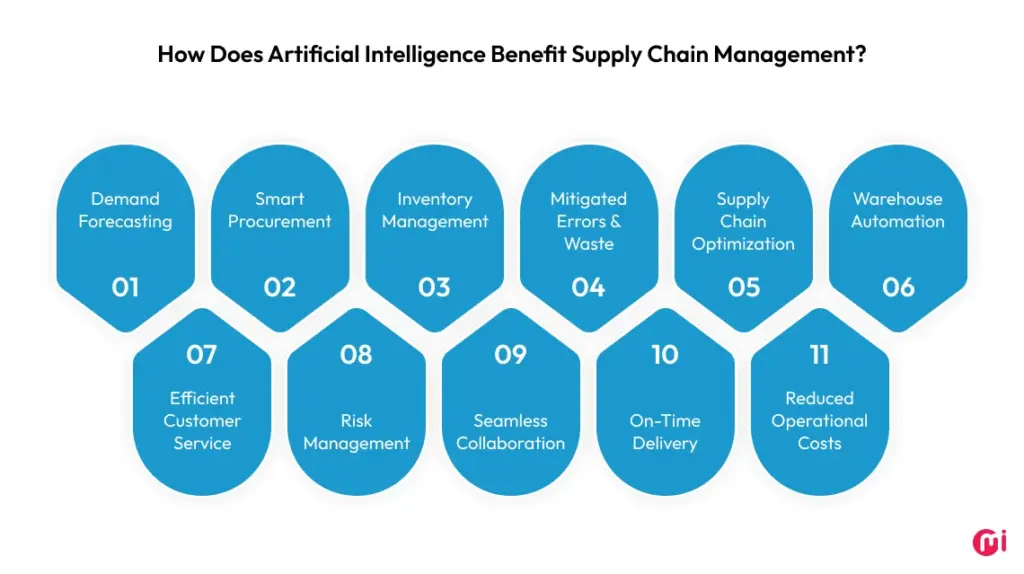
Image Source: MindInventory
ai trends 2025 proves its worth in supply chain operations through measurable results that show remarkable gains in efficiency. Organizations that use AI throughout their supply networks see 20-30% lower inventory levels, 5-20% reduced logistics costs, and 5-15% less procurement spend.
Smart machine learning models create surprisingly accurate demand forecasts by analyzing past sales data with market trends, seasons, weather patterns, and social media sentiment. These organizations have cut their forecasting errors by half while reducing sales losses from inventory shortages by up to 65%.
Ground applications showcase how artificial intelligence 2025 improves operational excellence. IBM saved $160 million by using several AI-driven supply chain solutions in its operations. The company maintained 100% order fulfillment even during peak COVID-19 disruptions. A major building products distributor saw 5-8% better fill rates after implementing an AI-enabled supply chain control tower that actively manages inventory levels.
enterprise ai trends 2025 finds new frontiers in warehouse optimization. AI-powered tools have discovered 7-15% extra capacity in warehouse networks by spotting daily spare capacity and boosting efficiency. A major logistics provider boosted warehouse capacity by almost 10% without adding space. They used an AI “digital twin” that precisely predicts how changes in labor, assets, and material flows would affect operations.
ai technology trends 2025 goes beyond inventory management with predictive maintenance that cuts costly downtime. These systems analyze sensor data live and spot subtle changes from normal operating patterns before equipment breaks down.
generative ai trends 2025 optimizes routes by factoring in traffic and weather conditions to suggest better shipping paths, which leads to fewer unexpected delays and faster deliveries. AI studies material quantities moving through warehouse aisles to recommend better floor layouts that speed up inventory access and cut travel time between receiving and shipping areas.
Ai in 2025 will change how supply chain simulations work. Operations planners can test different approaches without disrupting actual operations.
AI in IT: automation and security
IT departments utilize ai trends 2025 to transform operations through automation and security with measurable results. AI automation has reshaped IT workflows. It handles repetitive tasks, reduces costs, streamlines processes and allows human talent to focus on strategic initiatives.
AI-powered automation brings measurable improvements through intelligent systems. These systems analyze data, recognize patterns and make decisions without requiring explicit programming for every scenario. Teams that implement these solutions see 20-30% lower operational costs. They also report better precision in data entry, quality control and image analysis.
AI capabilities go far beyond simple robotic process automation (RPA). The technology tackles complex, data-rich tasks that need sophisticated decision-making. Modern AI systems can prioritize tickets based on urgency through sentiment analysis – something traditional automation systems struggle to achieve.
Artificial intelligence 2025 brings substantial value to cybersecurity. Organizations with AI security tools process about 78 trillion signals each day. They identify threats at unprecedented scale and speed. These systems detect unusual patterns and potential fraud by analyzing transaction data as it happens.
AI-driven security applications deliver clear business results:
- 60% reduction in fraud-related financial losses
- 80% decrease in false positives from security alerts
- 5x return on investment within the first year of implementation
Enterprise ai trends 2025 show that human-machine collaboration works best for cybersecurity operations. The Department of Homeland Security researches distributed learning and automated intelligent agents. These agents monitor networks for anomalies. The department also develops secure, connected multi-cloud environments that support AI testing.
Organizations measure AI performance through system metrics that focus on operations. These include reliability, responsiveness, throughput and resource utilization. Such metrics help learn about the health, performance and organization-wide effects of AI platforms and infrastructure.
AI in legal: contract review and compliance
Legal teams now use AI-powered tools that change how they handle contract review and compliance functions in the ai trends 2025 landscape. AI contract analysis technology can find useful legal data from thousands of documents at once. The system delivers results in seconds by understanding context rather than just matching keywords.
Organizations that use AI solutions have cut their review time by 80%. These tools can spot deal-breakers, pull out metadata, and flag missing clauses automatically. AI contract review has turned hours of work into a five-minute task while keeping high quality standards.
AI helps protect against growing regulatory challenges. The European Union’s development of the Artificial Intelligence Liability Directive puts more pressure on organizations to follow current and new regulations. AI compliance tools track legislative updates, understand regulatory texts, and evaluate their effects on business operations.
AI tools provide clear compliance benefits:
- They cut manual work for compliance audits by automating document reviews
- They reduce time needed to process whistleblower reports through AI summaries
- They automate personal data redaction with just a few clicks
Some limitations still exist. Current legal AI systems produce false information in about 1 in 6 or more standard queries. Retrieval-augmented generation (RAG) systems, designed to reduce these errors, still give wrong information 17-34% of the time in legal contexts.
The best legal AI systems in artificial intelligence 2025 will need human oversight for strategic legal analysis. One source explains, “In its nascent stage, AI can’t do what a lawyer can. Legal analysis and strategy, provided by humans and proprietary to individual clients, aren’t available through bits and bytes”. The future of enterprise ai trends 2025 in legal departments depends on humans and AI working together rather than AI replacing humans.
AI in R&D: accelerating innovation

Image Source: Forbes
ai trends 2025 brings a fundamental change to Research and Development departments by speeding up innovation cycles and product development timelines. Recent studies show that generative AI applications create 75% of their value in four key areas, with R&D emerging as one of the most promising opportunities.
AI’s effect on R&D shows through remarkable gains in efficiency. Companies using AI-driven R&D cut their product development times by more than 60%. They also achieve 25% lower costs and boost their workforce efficiency by more than 35%. Scientific AI changes laboratory research by combining various data sets. These systems can predict beyond their training parameters to uncover completely new findings.
The Department of Energy’s success proves these benefits. Their machine learning forecasts in solar energy research are 30% more accurate than conventional methods. This success drives organizations to build active learning loops that create unique insights by fine-tuning specific research domains.
AI changes the entire R&D approach beyond just making things faster:
- Pattern recognition – AI algorithms spot discrepancies and anomalies in large datasets that researchers might miss
- Error reduction – Automated tasks and secondary analysis lower the chance of human error
- Strategic decision enhancement – AI optimizes processes and cuts costs by removing guesswork from R&D
artificial intelligence 2025 reshapes R&D’s basic nature. It turns trial-and-error into digital processes that cut time spent on dead-end ideas. AI handles routine tasks so researchers can focus on creative problem-solving and real-life challenges.
Note that AI-driven R&D doesn’t replace human innovation – it increases it. Organizations that use enterprise ai trends 2025 in R&D report better efficiency and create more collaborative, forward-thinking workplaces.
Main Point 20
Companies that find the highest returns from ai trends 2025 use structural reorganization as their secret weapon. A recent McKinsey survey reveals a clear truth: workflow redesign yields the biggest effect on EBIT from generative AI among 25 tested attributes. The surprising fact remains that only 21% of companies have redesigned their workflows to help AI work better.
Leadership from the C-suite makes all the difference. Companies with the best artificial intelligence 2025 results point to CEO oversight of AI governance as the key factor in achieving higher profits. This means successful AI implementation starts with complete C-suite backing rather than just IT department involvement.
Successful companies choose hybrid approaches for their organizational structure. They typically use centralized models like centers of excellence for risk compliance and data governance. Their tech talent and AI solution adoption follow partially centralized models with resources spread across business units.
Enterprise ai trends 2025 reveal larger organizations leading these structural changes by:
- Creating clear roadmaps that drive AI adoption at twice the rate of smaller companies
- Setting up dedicated teams for generative AI adoption
- Strengthening internal communications about AI value creation
- Implementing role-based capability training at every level
Organizations restructure work assignments because of time saved through ai technology trends 2025. Employees now spend their automation-freed time on new activities or focus more on non-automated tasks. Larger organizations reduce headcount – a factor that significantly affects bottom-line value from generative AI.
Companies that want lasting generative ai trends 2025 value rewire their entire operations. They change not just how they deploy technology but completely rethink their approach to getting work done.
AI in product development: faster prototyping
AI is dramatically speeding up product development cycles through ai trends 2025 as machine learning changes traditional prototyping methods. The effect is remarkable—companies using AI-driven development tools see their product development cycles shrink by more than 70%. Teams can now test consumer preferences, refine designs, and optimize manufacturing in timeframes that seemed impossible before.
The speed difference shows up most clearly in visual concept creation. To name just one example, automotive OEM designers created 25 versions of a next-gen car dashboard’s interface in two hours with AI help—work that used to take at least a week. A team also created more than 2,400 different design images in just two weeks by using generative AI.
Artificial intelligence 2025 brings more than just speed to the prototyping process. AI-powered tools generate mockups and data models quickly, while they test multiple versions to find the best solutions. Work that once took months now wraps up in days or hours.
Enterprise ai trends 2025 turns prototyping into a decision support system at its heart. Machine learning models trained with simulation data can predict how early-stage prototypes will behave without building them or running long simulations. Designers now get live feedback on how changes affect the final design, which creates a flexible process that supports quick experimentation without losing quality.
Ai technology trends 2025 moves prototyping almost completely into the virtual world now. Virtual prototyping cuts material costs and lets teams examine millions of design variations. This capability goes beyond specialist teams—professionals who know simple coding can create functional prototypes, which lets skilled designers focus on improvements instead of starting from scratch.
Generative ai trends 2025 helps realize the potential of optimized design options. These engineering tools create many design alternatives based on set parameters, which helps product designers explore options that meet technical needs while cutting material usage and costs.